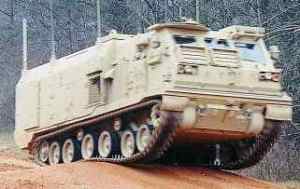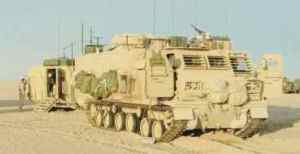| Designation: | M4 |
 |
|---|---|---|
| Manufacturer: | BAE Systems Land and Armament | |
| Product type: | Armoured Vehicles | |
| Name: | Command vehicle |
The now BAE Systems Ground Systems M4 Command and Control Vehicle (C2V) uses a design similar to that of the BAE Systems Ground Systems XM5 Electronic Fighting Vehicle Systems Carrier, but mission equipment differences dictate areas of change.
The M4 C2V uses a 10 m telescoping mast and has a primary power pack, environmental control unit and NBC overpressure system integrated into the mission equipment enclosures.
It is based on the standard BAE Systems Ground Systems Division Multiple Launch Rocket System (MLRS) carrier chassis which is used in large numbers by the US Army. The main modifications include the integration of the Bradley A2 600 hp Cummins diesel engine, L3 Combat Propulsion Systems HMPT-500-3EC automatic transmission and the upgraded suspension.
Engineering development commenced in the second quarter of 1992, with the six XM4 prototypes delivered in 1995 and subsequently sent to Fort Hood for extensive trials with the 4th Infantry Division.
Following trials the US Army type classified the system as the M4 Command and Control vehicle.
The US Army Tank-automotive and Armaments Command awarded BAE Systems Ground Systems a contract worth USD12.5 million for Low-Rate Initial Production (LRIP) of the M4 in the fourth quarter of 1996.
The first contract was to build five M4 vehicles with warranty during FY97 but the contract had three options years worth USD82 million for a total of 46 vehicles with deliveries running through to February 2002.
Production of the M4 C2V commenced at the now BAE Systems Ground Systems York facility late in 1997 and the first four vehicles were delivered to the US Army by late 1998. The first vehicles were built in San Jose but all subsequent production was undertaken in York.
In December 1998 a USD18.9 million contract was awarded for another 10 vehicles for delivery between August 2000 and May 2001. This brought the total order to 20 vehicles (5 + 5 + 10).
The total US Army requirement was for up to 439 M4 Command and Control Vehicles but the programme was cancelled in late 1999 to fund other programmes.
The company has proposed that the 20 M4 vehicles already fully funded could be converted into Armored Medical Treatment Vehicles (AMTV). As of late 2007 there were no plans for this conversion to take place.
In addition to tactical command and control vehicle applications, the M4 is re-configurable to an artillery or an air defence fire direction centre as well as an armoured medical evacuation vehicle.
In early 2003 it was revealed that the US Army had proceeded with the fielding of at least one of its recently terminated legacy systems, the company M4 Command and Control System.
In total 25 M4 Command and Control Vehicles were built before the programme was terminated and the company agreed to store them at their York facility and try to sell them overseas with US Government approval.
Late in 2002, the US Army asked if these vehicles could be re-fielded. In the end the company and army planners mutually agreed to set aside 10 vehicles for spare parts while re-issuing the 15 remaining vehicles for possible combat service.
Beginning in October 2002, the 15 systems were fielded to US Fifth Corps (three M4s), Third Infantry Division (three M4s); First Cavalry Division (four M4s), Third Armored Cavalry Regiment (two M4s) and the First Armored Division (three M4s). Some of these units were subsequently deployed to the Middle East and took part in the invasion of Iraq.
As of late 2007 there were no plans to put the M4 Command and Control Vehicle back in production for the US Army.
The cab and mission module is of all-welded aluminium construction that provides the occupants with protection from small arms fire and shell splinters. A modular passive armour kit is available for more advanced threats.
The three-person cab is at the front and is provided with forward-opening side entrance doors and roof hatches. To the immediate front of the crew are three larger windows, which can be rapidly covered by armoured shutters from within the cab.
The fully enclosed mission module is at the rear with entrance via a large door in the rear, there is also an emergency hatch in the roof. The interior communications and workstation fit depends on the mission requirement and arm of service.
Suspension is of the torsion bar type with each side having six dual rubber-tyred road wheels with the drive sprocket at the front and the idler at the rear. There are four track return rollers with hydraulic shock-absorbers being provided for the first, second and last roadwheel stations.
Specialised equipment includes a Cummins diesel-powered APU, 10 m hydraulically operated mast, which can be raised or lowered in 30 seconds (maximum).
The M4 is completely self-contained without need for trailers or support vehicles for extended mission performance. Onboard subsystems provide adequate power for mission operations plus NBC protection and environmental control.
|
||||||||||||||||||||||||||||||||||||||
|
||||||||||||
|
||||||||||||
 |
 |
 |
 |

